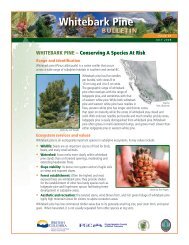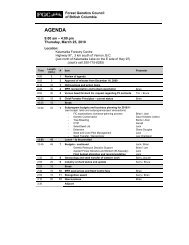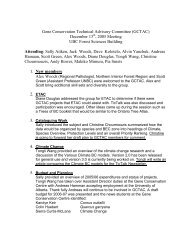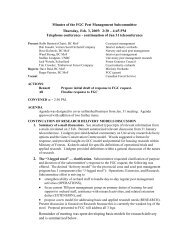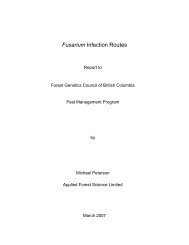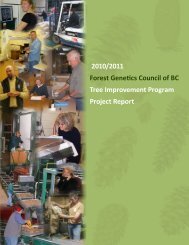Tree Improvement Program Project Report 2006 / 2007
Tree Improvement Program Project Report 2006 / 2007
Tree Improvement Program Project Report 2006 / 2007
You also want an ePaper? Increase the reach of your titles
YUMPU automatically turns print PDFs into web optimized ePapers that Google loves.
Cl mate Change<br />
ClimateBC: Our ClimateBC model continues to be<br />
used widely in forestry research in BC and the number<br />
of non-forestry related applications is growing rapidly.<br />
CFGC Assistant Director Tongli Wang is upgrading it<br />
continually. Version 3.1 beta, including historical (1901<br />
– 2002) monthly climate data and 1971-2000 normal data,<br />
has been developed and is now ready for download from<br />
the CFGC website. ClimateBC v3.2, which will use finer<br />
(change from 1° to 0.5°) annual anomaly input data, is in<br />
development. The web version of ClimateBC v2.3 has been<br />
upgraded to version 3.1.<br />
Response of lodgepole pine populations to future<br />
climates: This work used growth response functions to<br />
determine the performance of each population in the<br />
Illingworth provenance trial along climatic gradients<br />
(Wang et al. <strong>2006</strong>). Results of this study suggest 1) the<br />
importance of using reliable climate models in genecology<br />
to avoid misleading conclusions and using anchor points<br />
and multivariate functions to improve the growth response<br />
functions; 2) that populations from the south are not<br />
necessarily the best choice for future climates; 3) the<br />
identity of populations adapted to a broad range of climatic<br />
conditions, particularly from NE low and PG low; and 4)<br />
that the potential for using optimized seed source selection<br />
to mitigate climate change is substantial.<br />
Graduate student Sierra Curtis-McLane is examining<br />
annual radial growth in lodgepole pine relative to changing<br />
climate patterns in British Columbia as part of her PhD<br />
research. She collected tree cores spanning 25-30 growth<br />
rings from nine provenances on 15 sites of the Illingworth<br />
provenance trial and is analyzing them to assess annual<br />
genotype-by-environment interactions across a spectrum<br />
of climatic conditions. She measured the tree rings using<br />
standard dendrochronological techniques and will use<br />
the measurements to analyze inter-annual variation in<br />
provenance growth in relation to weather records. She<br />
will compare the results to these provenances’ predicted<br />
responses to changes in climate.<br />
Predicting future distributions of ecosystems and<br />
seed planning units: Andreas Hamann and Tongli Wang<br />
used the ClimateBC model in their landmark <strong>2006</strong><br />
publication in the journal Ecology that predicted the future<br />
distribution of climates currently associated with BEC<br />
zones and tree species in BC (Hamann and Wang <strong>2006</strong>).<br />
As a continuation of this work and because small spatial<br />
units do not translate well into operational practices, Tongli<br />
Wang has developed a maximum probability approach to<br />
T R E E I M P R O V E M E N T P R O G R A M<br />
P R O J E C T R E P O R T 2 0 0 6 / 2 0 0 7<br />
predicting the future distribution of BEC zones and SPUs<br />
without extensive fragmenting across BC landscapes. We<br />
hope that these methods will be quite useful in the revision<br />
of seed transfer guidelines in anticipation of climate change.<br />
Incremental FIA Cl mate Change <strong>Project</strong>:<br />
Short-term testing of provenances and genotypes to<br />
predict response to climate change and adapt seed<br />
transfer policy: Because relatively few species have<br />
comprehensive provenance trials spanning a sufficient<br />
range of climates to derive provenance response curves,<br />
we are attempting to derive such curves based on seedling<br />
growth and phenology in controlled growth-chamber<br />
environments. Our current experiment builds upon<br />
research completed in 2004-2005, which investigated the<br />
response functions of lodgepole pine to temperature and<br />
CO 2 . The previous study found that height and volume<br />
growth of seedlings in controlled environments peaked at<br />
a simulated mean annual temperature (MAT) of 9°C or<br />
higher, whereas this peak was estimated to occur somewhere<br />
between 3 and 6°C in the field (Wang et al. <strong>2006</strong>). The<br />
most important difference, we believe, was that our climate<br />
regimes in the growth chambers were built to simulate<br />
monthly averages of daily average temperature and daily<br />
temperature range rather than daily variations as in real<br />
weather and did not include any application of drought.<br />
The new experiment includes more realistic climate<br />
regimes based on climatic means for locations with MAT<br />
4°C, MAT 7°, MAT 10°, and MAT 10° + 2 x ambient<br />
CO 2 , with daily variations added around weekly and<br />
monthly temperature averages. Each temperature regime<br />
includes both well-watered and drought treatments. The<br />
new experiment contains approximately 20 seedlots each<br />
of interior spruce and lodgepole pine, including both<br />
natural stands and improved seed orchard lots from across<br />
a broad geographic range. Most of the interior spruce<br />
seedlots are also part of a recently established, large field<br />
trial (the Sx genecology trial EP 670.71.12), and the wildstand<br />
lodgepole pine seedlots are also represented in the<br />
Illingworth trial. This will allow us to compare growthchamber<br />
data with field-growth performance later on.<br />
Seedlings are planted in boxes that allow for extensive root<br />
competition; this makes drought treatments more realistic.<br />
Plant height is being measured bi-weekly, and the growing<br />
season lasts 26 weeks. The experiment will be replicated<br />
twice, once now and again in winter, <strong>2007</strong>-08.



